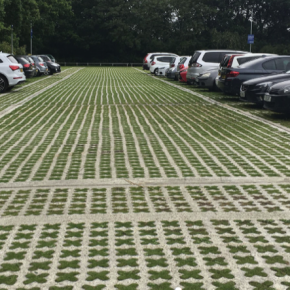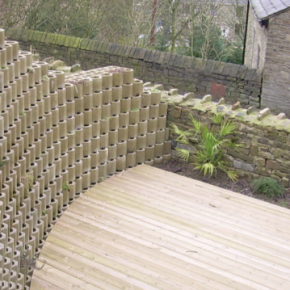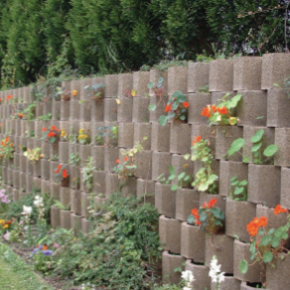
ABC&D ARTICLE: Growing Concerns – Urban Design and Landscaping
With increasing demand to green-up hard landscaped areas, grass paving and living walls have fast become the design option of choice for urban planners, architects and specifiers. The benefits can be significant but it is important to consider the fit-for-purpose choices for different applications. Solutions provider, Grass Concrete, explains why in this article…
A reinforced grass system can help permeate heavy rainfall and address SuDs issues, providing obvious advantages over traditional hard paved landscapes with their increased run-off into storm water channels.
One significant benefit of a grass paving system is that it can help store rainfall within the system, with low risk of ponding, until the ground can naturally recharge.
This lag time aids the prevention of flooding and can be extended by introducing an underlying drainage blanket across the full extent of the paved area.
The drainage blanket can be used to either attenuate permeation to the water table or be a vehicle for rainwater harvesting.
With a growing selection of glass paving systems available, specifiers now have a wide choice of products to choose from.
However, without the clear guidelines of an industry standard it is possible to end up with a product that might be fine in the short term, but will not stand the test of time and, in turn, not achieve any degree of sustainability.
Future proofing is essential for grass paving
Take, for example, a car park in daily use – to ensure the correct product is specified, ask the question: “Will the grass cover, and the structure itself, stand up to regular traffic?”.
For housing developments, for example, emergency access roads must be able to support the weight of modern fire and access vehicles with weight capacities up to 18 tonnes.
However, also take into account the potential for other types of heavy traffic, such as refuse and skip vehicles.
Consider the strength of the structure underneath the grass paving: Cast on-site concrete or pre-cast concrete provide a much heavier-weight system compared to plastic systems, so specifiers must decide which type is fit-for-purpose.
Designers need to carefully consider the grass paving types, particularly when likely to be subjected to frequent traffic.
A relatively thin layer plastic paver might suffice for light traffic or secondary parking but will not stand the same test of time as a reinforced concrete system.
This problem is exacerbated when plastic pavers are infilled with gravel – with no grass to provide tensile anchorage, vibration from traffic across the surface will naturally cause a sieving effect that can lead to loss of the gravel into the base below.
The gravel can also rotate, resulting in an abrasive effect on the side walls of the plastic grids.
In each case the likely outcome is a break-up of the structure. Good grass coverage is essential to achieving the green vista many clients desire. Many grass paving systems rely upon grass to anchor the system in place, the depth and shape of the soil pockets therefore has a critical part to play if grass cover is to be sustained.
Adopting grass paving on driveways and car parks is a growing trend to address issues of greener external works. For both commercial and domestic car parks and driveways there are options for concrete grass reinforcement.
Specifiers can turn those large parking areas into sustainable green vistas with sustainability built in. Grass paving systems can have an increasing role in sustainable harmonised urban landscapes.
They provide fantastic green areas where once only asphalt was considered. Besides going green at ground level, many designers are looking at vertical landscaping to enhance the green envelope.
Vertical landscaping brings different shapes and styles and can help reduce noise levels, with attractive planting providing colour, shape and a textured finish.
Living walls can be particularly useful in providing vertical green options where space is a limiting factor. They can provide adequate soil pockets for all types of plants, shrubs and climbers.
Good drainage and water capture help keep maintenance to a minimum. Vertical landscaping can enhance sound suppression and offer quick landscaping results across a wide walled area.
Structurally, living walls can be made of simple, interlocking blocks and dry-built with a free-form layout for a relatively quick and easy construction process that is able to cope with complex curves.
Latest news

26th July 2024
Enfield Speciality Doors completes world-class project for Atlas Copco HQ
A rundown office and warehouse building completely transformed into a modern headquarters for Atlas Copco has been fitted with more than 120 internal fire doors from Enfield Speciality Doors.
Posted in Access Control & Door Entry Systems, Articles, Building Industry News, Building Products & Structures, Building Systems, Case Studies, Doors, Interior Design & Construction, Interiors, Posts, Restoration & Refurbishment, Retrofit & Renovation, Security and Fire Protection, Sustainability & Energy Efficiency, Timber Buildings and Timber Products, Wooden products
26th July 2024
Abloy UK launches new white paper
Abloy UK, a leading provider of security and access control solutions, has launched a new white paper.
Posted in Access Control & Door Entry Systems, Architectural Ironmongery, Articles, Building Industry News, Building Products & Structures, Building Services, Doors, Facility Management & Building Services, Health & Safety, Information Technology, Innovations & New Products, Publications, Research & Materials Testing, Security and Fire Protection
26th July 2024
MCRMA Member Profile: David Roy, Director of Roofconsult
David Roy of MCRMA member company Roofconsult has more than 50 years’ experience to draw upon working in the building envelope sector and a unique perspective on how it has changed in that time.
Posted in Articles, BIM, Infrastructure & CAD Software, Building Associations & Institutes, Building Industry News, Building Products & Structures, Building Services, Building Systems, Cladding, Information Technology, Restoration & Refurbishment, Retrofit & Renovation, Roofs, Walls
26th July 2024
Strand: Enhancing Door Functionality and Safety
Craig Fox, Sales Director for Strand Hardware, outlines how door industry professionals might apply door limiting stays…
Posted in Architectural Ironmongery, Articles, Building Industry News, Building Products & Structures, Building Services, Doors, Facility Management & Building Services, Health & Safety, Restoration & Refurbishment, Retrofit & Renovation
 Sign up:
Sign up: 
